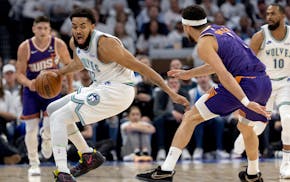The following few paragraphs are from a piece I did for 1500espn.com in February:
It's widely believed that Super Bowl-winning coach Mike McCarthy was not the Green Bay Packers' top choice in January 2006. In fact, if Brad Childress had gotten on an airplane to Green Bay for leverage in negotiations with the Vikings, he might not have left without signing a contract. It's a reminder that any team's top choice isn't necessarily the right one. Take "U" athletic director Joel Maturi. When searching last winter for the right guy to take over the Gophers football program, he swung and missed on now-Michigan coach Brady Hoke and, word has it, did the same with now-Maryland coach Randy Edsall. He ultimately landed Jerry Kill. And the decision reeked of cheapness after hearing about the contract Kill got -- just $1.1 million plus incentives in his first year, the same as new and first-time Indiana coach Kevin Wilson's deal. But after talking to numerous individuals since mid-December -- Kill's college roommate, Gerald Young; high school coaches; reporters who covered Kill at Northern Illinois; and college assistant coaches who have competed against him -- it has become clear Maturi made a good call. ----------------------------------------------------------- If you don't believe me on the above, talk to Gophers' defensive coordinator Tracy Claeys who has been with Kill for 16 years. Or, if you need an unbiased view, reach out to any number of journalists from his previous stops. When talking with Claeys in the offseason, I asked him if there's something that would surprise us about Kill. His response: "When we went to Southern Illinois (in 2001), we all lived in the same apartment, including him. Four in one, four in the other. He wants to be one of the guys. That's why our staff is close. He's never separated himself from the assistants. When we got here, he asked for a locker down in the coaches locker room. He likes being one of the guys. He got a big raise after our first winning season at Southern (Illinois). After our second winning season, another school offered him a job, so Southern offered him more money. He said he wouldn't take another dime until the assistants were taken care of. Sure enough, he got us a really nice raise." That is one of many examples of the cohesion that exists inside the team's facility. Kill's staff will do anything for him. They genuinely enjoy working for him, and more so, with him. This is why I can't figure out how from the final points three weeks ago against North Dakota State through Purdue's 31-0 lead on Saturday, the Gophers were outscored 95-0. Over their last 11 quarters, they have a point differential of minus-106. There was an assumption, maybe foolishly, that this staff's experience would equal a level of respectability this year. That among the time with the players in January-March for conditioning, spring practices, instructions given for captain's workouts, and now August, September, and October practices and games, some sort of translation would show on the field. I get that many inexperienced players are getting snaps, which they should at this point. I get that the fifth-year and sixth-year seniors have been through multiple systems and coaches. I get that many academic issues exist. I get that ex-coach Tim Brewster left a mess. But at what point can those justifications stop being used? When Kill says, "this is not a one, two, or three-year fix," it's hard to disagree. But after paying good money for parking, tickets, and concessions, it is not unreasonable for the fanbase to expect at least minimal return. Halfway through the season, the team is regressing, not progressing, with a tougher schedule forthcoming. Homecoming is next vs. 5-1 Nebraska, and all I can hope for is that it doesn't resemble the bloodbath of 1983, when Nebraska won 84-13. Thankfully, it shouldn't mostly because the '83 Nebraska team is one of the best in the last 30 years of college football. But that's what this year has turned into for passionate Gophers' observers: optimism that it doesn't turn into the most memorable collection of inefficiency in program history.

KAT was in foul trouble, but Timberwolves didn't flinch
Olympian Kristi Yamaguchi is 'tickled pink' to inspire a Barbie doll

Wolves smother Suns 105-93 to go up 2-0 in playoff series

